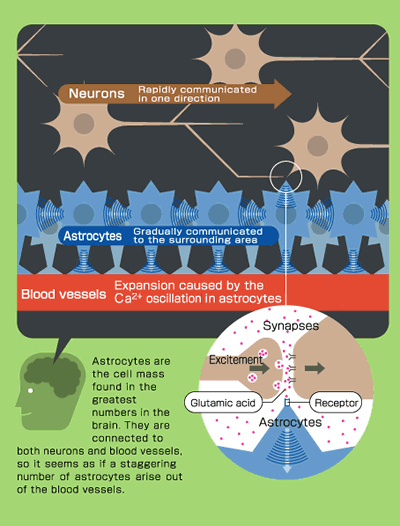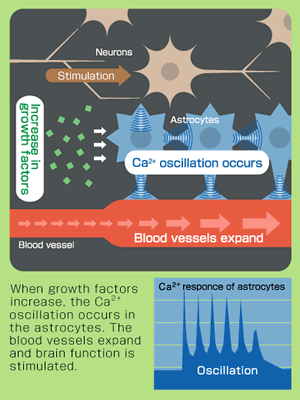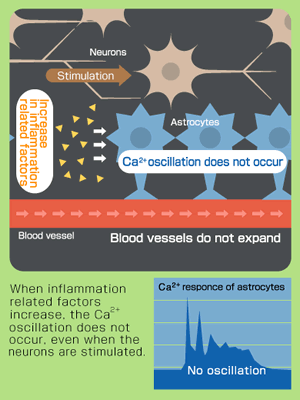| Research: Index > Astrocytes, supporting adaptable brain function |
| Astrocytes, supporting adaptable brain function | |
| |
|
One activity of the brain receiving stimulation today is the secretion by neurons of neural transmitter substances, such as glutamic acid, through synapses. The focus of this stimulation is on the function that rapidly conveys excitement in one direction.
We have learned, however, that astrocytes, a type of glial cell that gradually transmit excitement to surrounding cells, regulate the operation of all areas, including the sensory area and the activity area in the cerebral cortex. Astrocytes have receptors for glutamic acid, just as neurons do. Receiving glutamic acid from neurons raises the concentration of calcium (Ca2+) in the cells. This repeated increase and decrease—in other words, the Ca2+ oscillation, is transmitted to the astrocytes and the adjoining neurons. Astrocytes are also connected to blood vessels, so this Ca2+ oscillation expands the blood vessels. This in turn increases blood flow in the brain, and stimulates brain function. The astrocytes’ Ca2+ oscillation shows a diverse range of response patterns, in which it occurs and does not occur. We think the substance that regulates this diversity of response patterns is important for adaptability in brain function, and we set out to find it. |
 |
| The astrocytes cultivated in blood serum have as diverse a range of Ca2+ response patterns as the astrocytes in the brain. We tried cultivating them in a serum-free defined medium with added environmental factors that caused increases or decreases locally in the brain. The Ca2+ oscillation will occur after adding growth factors that increase through learning and activity. The oscillation will be limited when adding inflammation related factors, which increase with stress and aging. We can postulate that this is adjusted within the brain by antagonistic environmental factors. Roles are allocated to each region in the human brain. Integrating these roles results higher brain function. Astrocytes reflect with adaptability the environment in each region, and they create the diverse Ca2+ response patterns. It is no exaggeration to say that they support the foundation of brain functioning. In the future, we expect that the apprehension of the entire brain, including astrocytes and not just neurons, will prompt the search for a new direction in technological development in medicine and healthcare slightly different from that of the past. |
|
| ||
|
|
Are they similar or different? Photosynthesis and the aerobic respiration | ||
|
|
Mandala - Viewing as a whole | ||
| Rsearch |
|
Please close a window with the button of a browser who are turning off Javascript. |

